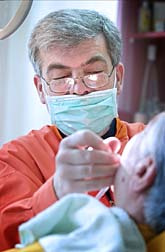 Fosamax is the commercial name for alendronate, which is a bisphosphonate drug designed to increase bone density in post-menopausal women and men suffering with osteoporosis - a huge market as the baby boomer age wave thunders into retirement. Adverse effects associated with Fosamax (and identified early on) include trouble swallowing, and problems with the oesophagus. In March of 1996, Merck contacted doctors indicating that reports of irritations of the oesophagus were proving more widespread in the post-approval marketplace than their own clinical trials revealed. It was suggested that not taking the medication according to strict usage guidelines, could lead to such irritations.
Fosamax is the commercial name for alendronate, which is a bisphosphonate drug designed to increase bone density in post-menopausal women and men suffering with osteoporosis - a huge market as the baby boomer age wave thunders into retirement. Adverse effects associated with Fosamax (and identified early on) include trouble swallowing, and problems with the oesophagus. In March of 1996, Merck contacted doctors indicating that reports of irritations of the oesophagus were proving more widespread in the post-approval marketplace than their own clinical trials revealed. It was suggested that not taking the medication according to strict usage guidelines, could lead to such irritations.There was no reference, in the Merck correspondence eleven years ago, to the potential for osteonecrosis of the jaw (ONJ).
But then doctors - and dentists - started to notice something: the jaws of patients having failed to heal properly after oral surgery. Dr. Salvatore Ruggerio, who in 2005 was Chief of Oral and Maxilofacial surgery at the Long Island Jewish Medical Centre, was quoted in USA Today (March 2005) that over a three-year period he had seen dozens of patients with portions of their jawbones effectively dead and exposed - a rare condition often referred to as 'bone death' or dead jaw syndrome.
Dr. Ruggerio said that at the time it was not uncommon to see such a condition in cancer patients having direct radiation to the face.
However, further investigations revealed that while most of the patients presenting ONJ were being given bisphosphonates in IV form, about 10 per cent of the patients Ruggerio studied were taking bisphosphonate in tablet form - mainly Fosamax.
These revelations came to light in May of 2004, in a report co-authored by Dr. Ruggerio and appearing in the Journal of Oral and Maxillofacial Surgery. His report centred on a study of 63 osteonecrosis patients, six of whom had taken Fosamax. Dr. Ruggerio observed that while the risk factors for dead jaw syndrome were less severe in patients taking an oral form of bisphosphonate vs.: the IV form, the possibility for developing ONJ remains.
Based on these findings, the U.S. Food and Drug Administration (FDA) went on record as suggesting, in the spring of 2005, that a risk for osteonecrosis of the jaw exists with all bisphosphonates, oral and IV alike - and concluded that all bisphosphonate labels should include a reference to osteonecrosis of the jaw.
Merck complied. However, the manufacturer appears to have downplayed the ONJ issue by referring to it in product guides and summaries almost as an afterthought. In leaflets dated July 2005, osteonecrosis of the jaw is referred to this way: "Rarely, patients have had jaw problems associated with delayed healing of an infection, often following tooth extraction." This caveat comes as the last line of a long section dealing with side effects, and other adverse affects. Far more emphasis is placed on things such as potential irritation of the oesophagus, stomach upset, and so on.
In the more detailed patient information, included as an insert in the Fosamax box, osteonecrosis of the jaw is given a little more sway, but is buried in the small print that most people would probably never read anyway, and most older Americans suffering from osteoporosis, would in likelihood also be suffering from diminished eyesight. Dealing with small print can be a painful experience in itself.
Since its introduction, Fosamax has been prescribed to nearly 10 million men and women for treatment of osteoporosis. There have been 2400 reported cases of ONJ, or dead jaw syndrome, since 2001.
READ MORE LEGAL NEWS
The highest risk factors for ONJ are:
• taking bisphosphonates, especially in IV form
• concurrent use of steroids
• previous history of cancer, osteoporosis or Paget's disease
• traumatic dental procedure, such as tooth extraction or dental implants.
It is alleged, in Fosamax lawsuits, that the manufacturer knew about the potential for ONJ - which in serious cases can result in partial disfigurement of the face - but was not forthcoming. The placement of references to osteonecrosis of the jaw in product information, just adds to that suspicion.
Fosamax is the global leader for bisphosphonates, with sales of $3.2 billion in 2005, according to the Associated Press. It is Merck's second-best performer.
